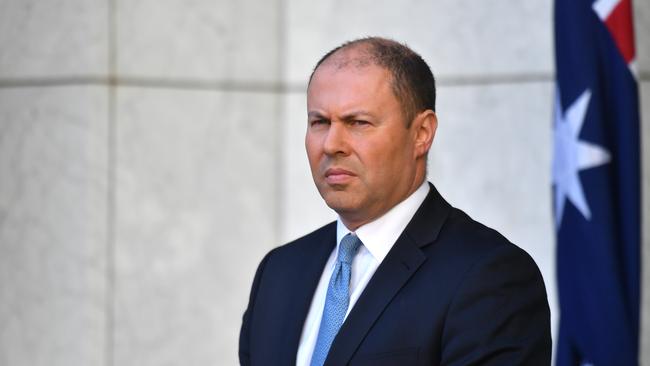Rubicon crossed on fiscal spending

When the 2020-21 budget is brought down on October 6 the deficit will be well into nine figures, potentially $200bn, or 10 per cent of a reduced GDP number (GDP is probably in the process of contracting by 10 per cent, to $2 trillion).
After the global financial crisis, it took a decade to get the budget back to balance — or rather the now dashed hope of balance — because of the relentless pressures on government spending from disability and healthcare and the Coalition’s refusal to increase taxes apart from bracket creep.
Annual cash deficits over those 10 years totalled $361bn. Government debt increased from $101bn in 2008. It was $257bn when the Coalition won the 2013 election, and is $542bn now.
That was from a starting deficit in the GFC year of 2008 of $31.3bn; what will the next 10 years of deficits add up to if the starting point is, say, $200bn?
Unless China rescues the budget with a commodity boom as it did between 2004 and 2007 — which is not impossible — or the Coalition breaks the habit of a lifetime and significantly increases taxes, government debt is likely to be at least $1 trillion quick smart, more than double what it is now.
The word from Josh Frydenberg is that the government will quickly get control of spending and return the budget to surplus because the support measures announced so far are temporary, which is true. But if the October budget predicts a surplus in, say, 2023-24, we would rightly take that with a grain of salt.
Wayne Swan’s 2010 budget projected a surplus of $1bn in 2012-13, rising to $5.4bn the year after. The actual numbers turned out to be deficits of $21bn and $52.4bn. As Maxwell Smart would say: “Missed it by that much.”
How quickly nominal GDP snaps back from the coronavirus recession is impossible to predict, but the experience of past recessions is that even if it does snap back it always takes more than a year or two to translate into higher taxes and less welfare.
In fact, the most likely future for the Coalition is that it will be the second government in a row never to produce an actual surplus, as opposed to forecasting one, before heading back to opposition in a term or two. That won’t be Scott Morrison’s or the treasurer’s fault, but finishing up with more than a trillion dollars in debt is not the legacy they would have hoped for, and destroys the Coalition’s political positioning as the party of small government, surplus budgets and low debt.
The good news is that most of it will probably end up being owned by another arm of government — the Reserve Bank.
Since launching its own version of quantitative easing a couple of weeks ago, the RBA has been buying about $3bn a day of bonds on the secondary market. If it keeps up that rate, the central bank would take about three months to buy all the $213.6bn debt to be issued to fund the three coronavirus stimulus packages.
In fact, it could own all the debt to be issued to fund the coming decade of deficits, simply by continuing to buy $2bn-$3bn a day on the secondary market, taking Easter and Christmas holidays off.
The RBA could, theoretically, buy the bonds directly from the Australian Office of Financial Management at primary auctions, but there is little stomach among any central bankers to do that. The Bank of Japan has done some of that, but, well, that’s Japan.
But banks and other private institutions would be only too happy to buy bonds from the AOFM in order to warehouse them briefly and sell them to the RBA the next day, for a small margin of course.
The basic point is that what we are seeing now is a merger of fiscal and monetary policy: the task of QE is not to support asset prices by lowering the risk-free rate, aka the bond yield (although that’s what they say it is), but to soak up the excess supply of bonds.
The question that nobody has answered yet, and that nobody really wants to answer, is: what happens when the bonds mature? The RBA can forget selling them before maturity; the Federal Reserve tried that and it didn’t work.
When a bond matures, the owner receives the face value in cash from the issuer. If the owner is owned by the issuer, such as a central bank, then an internal transfer would take place. Or not.
The problem with “or not” is that it would represent the “monetisation” of government debt, otherwise known as Modern Monetary Theory, and it is something that any self-respecting central banker and Treasury official regards as intolerable, to be warded off with garlic and crucifixes.
Why? Because politicians cannot be trusted with an unlimited supply of money, and must be shackled by the leg irons of public debt. If they came to realise that government spending could be financed by the central bank printing money, where would it end?
The trouble is that the world is entering a stage where public debt is so big it loses all meaning. When something that is meant to constrain becomes that large and loose, it no longer constrains.
So what is to be done with all the government debt that is going to end up being owned by global central banks, including the RBA?
I have no idea, but I doubt it will be repaid. As David Plank of ANZ Research told me this week: quantitative easing is the Hotel California: “You can check out any time you like, but you can never leave.”
Alan Kohler is the editor in chief of Eureka Report






The Coalition’s conversion to aggressive fiscal expansion this week was a fully justified response to an emergency, but a Rubicon has been crossed.